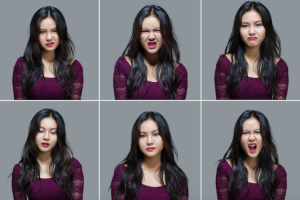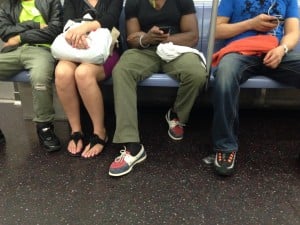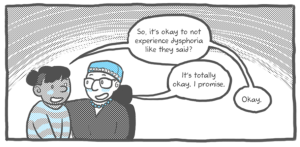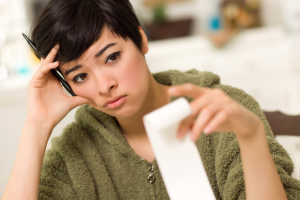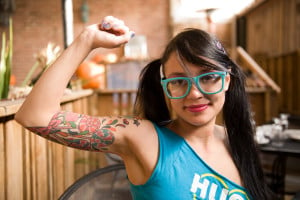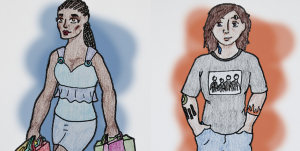“Don’t wanna be your exotic, some delicate, fragile, colorful bird, imprisoned caged, in a land foreign to the stretch of her wings…” —Suheir Hammad
“Your eyes are like almonds.”
“I want your hair!” “Your hair has such great texture.”
“Asian women are all so beautiful.”
“Are you as spicy in bed as you look?”
“You look so exotic!”
Thank you? I think…
I’ve heard all of these from my friends, folks I’ve dated, and even random strangers. While these statements might all sound like compliments, they’re not.
Although I’m from the Midwest, I often get treated like I am a piece of tropical fruit.
Google the word exotic. As an adjective, it means “originating in or characteristic of a distant foreign country” and examples include “exotic birds” or “exotic places.” Synonyms include foreign, nonnative, tropical, introduced, or imported. Or, if you’re using exotic as a noun—well—you’re referring to an exotic plant or animal.
Hmmm. Those don’t seem like a way to compliment someone.
Despite the intention to express a compliment, what is actually being communicated when you call a woman of color “exotic” is a backhanded reminder that we are less normal, less human, and less real than white folks.
I’ve dated men who seem to have a “Pokemon” approach to women of color – they have to collect us all.
My rejection of the word exotic as a way to describe me might seem like I’m making a big deal out of something when someone is just trying to be “nice” to me. And true, some women of color might not individually find being called exotic harmful.
But statements like “You’re so exotic” are laden with histories of ways women of color have been oppressed sexually and they continue to ‘other’ us by creating both a geographical and ideological distance between us and everyone else. Exotification serves as a way to dehumanize and simultaneously put us up on an unrealistic pedestal.
While all women of color aren’t oppressed by racialized sexism in exactly the same ways, our bodies are all still constantly under scrutiny.
Below are four reasons why calling a woman of color exotic is racist.
1. Exotic Implies There Is One ‘Normal’ Standard of Beauty
“You’re beautiful for a [insert non-white race here].”
Women of color are seen as exotic because we look different than the mainstream beauty ideal, which is almost exclusively white. And while some beautiful women of color have achieved recognition in mainstream culture, media representations “whitewash” these women by lightening their skin or shrinking their bodies.
Exotification is a reminder that women of color fail to meet Western, white standards of beauty that favor light skin and eyes, straight hair, and thin figures.
Beauty standards are a form of social, economic, and cultural currency – beauty is a big deal because it shows up in whether or not individuals are treated with dignity and respect by society.
For example, the way a Black woman wears her hair, whether it conforms or not to white standards of beauty, might impact whether or not she gets hired for a job.
When beauty is in the eye of the beholder – and the beholder is often a white, cis-heterosexual man – beauty narratives become racialized.
While white women are also burdened by standards of beauty, women of color are completely alienated and “othered” from this ideal. An “exotic woman” is never truly seen as beautiful on her own terms.
Different cultures may might also have different beauty ideals, but the idea of one idealized beauty standard is impossible and unattainable. We don’t all look the same and can’t be expected to all look like a very limited cookie-cutter version of perfection.
For example, Asian women, who are sexualized as passive and submissive, are then also expected to be small and delicate when measured under white beauty standards.
Our beauty is not really seen as true beauty.
Exotification comes with fixations on things like skin color, hair, body size, eye shape, or other body parts. This shows up in ways people might obsess over Asian women’s “almond” eyes, “silky black” hair and petite figure; the fetishization of Black women’s butts and preoccupation with their hair; the unwarranted curiosity of where these body parts actually come when fascinated by the racial ambiguity of mixed race women.
This also shows up in the ways that often times our bodies are simultaneously seen as unwanted. Asian eyes are thought to be slanted, small, and sinister. Black hair is kinky and weird. Dark skin is degraded.
In 2014, Nina Davuluri became the first South Asian American woman to win the Miss America pageant – yet the response was overtly racist. As an Indian American, her non-white body, her presence, and her beauty was seen by many in the American public as too foreign to be truly beautiful.
Or, when Lupita Nyongo won the Academy Award for Best Supporting Actress, her beauty, her body, and her dark skin became a media spectacle.
Women of color can be simultaneously hyper sexualized and desexualized, creating feelings that our bodies just aren’t quite right. We’re made to feel like we deserve the worse ways we’re treated because of the way we look.
These racialized beauty narratives impact us emotionally, mentally, and physically as we toil to look like a body we were never meant to look like or work to be okay with our bodies and our looks despite negative societal feedback.
2. It Reduces Women to the Status of Exotic Animals
The “Dragon Lady” and “Lotus Flower” stereotypes draw on images of exotic flora and fauna to describe East Asian women. Indigenous women are pictured as primitive and savage. The fashion industry frequently portrays Black women as animalistic, draped in animal prints, and sometimes literally caged.
By perceiving women of color as exotic, you’re also imagining us as wild animals who need to be tamed. This is often used in conjunction with the depiction of men of color as dangerous predators and beasts.
This can be seen most literally in how explorers and colonizers paraded what they perceived as “primitive” Native people around like trophies as a way to show off their discovery of “exotic lands.”
Human zoos that showcased Indigenous people from Asia, Africa, Latin America, and Australia have existed from the 1500s until the 1950s. People of color were treated as attractions and exhibited in cage in arenas such as the World’s Fair, where millions of people flocked to see the “exotic.”
People of color were literally animals on display in a zoo.
Ota Benga was put on display in the primate exhibit at New York City’s Bronx Zoo after being kidnapped from his home in the Congo.
Saartjie Baartman, a twenty-year-old woman born in southern Africa of the Khoisan people, was exploited as a “freak” exhibit. Objectified and exhibited, her butt was constructed by the Western public as “unnaturally” large. Her body, similar to that of other women in her community, was perceived as “abnormal.”
Her life is not just a past moment in history, but part of ongoing exploitation and objectification.
The perception and treatment of women of color as “exotic” animals shows up in the ways that our bodies are disrespected, exploited, and consumed on a daily basis – like being touched without consent or how our bodies and sexualities are turned into jokes, fetishes, and fleeting trends.
Being seen as “white” was and is being seen as normal, human, and racially superior. People of color are then treated as both less than and also as fascinating curiosities and aberrations of what it meant to be human.
Today, women of color also continue to be bought and sold – the majority of human trafficking victims are people of color. Seen more like things to be possessed and less like humans, people of color are treated with the same oppression as exotic creatures to be captured and used.
Further, when exotic women of color get equated to animals, animals often get more empathy and justice than we do.
As women of color we can be and are fierce and strong, that ferocity is ours and ours alone – not to be turned against us or taken away from us by turning us into commodities.
I am not your lotus flower or your submissive, servile pet. I am a human being who deserves dignity, respect, and an opportunity to live my life free of blatant or benevolent oppression, But unfortunately, institutions of whiteness and imperialism have neglected to recognize this for centuries.
3. Both Media and History Continue to Portray Exoticism in Harmful Ways
Stereotypes of exotic “spiciness” stem from histories that first perceive women of color as uncivilized and savage.
The depiction of women of color as exotic and from “faraway lands” is pervasive throughout mainstream media, from pop songs with lyrics about traveling the world to sleep with “all kinds” of women to people of color depicted as props or backdrops in fashion magazines.
The fetishization of women of color, which also perceives our bodies as less than, as objects to be conquered, as exotic spices to be discovered traces back to colonial legacies that justified rape and enslavement.
These histories of colonization get rewritten and trivialized by popular culture.
In the Disney version of history, such as in Pocahontas, there’s a whole song about the Native Americans as “savages, savages barely even human.” When I was a kid watching this movie, the ramifications of equating Native people to savages didn’t sink in – it was just taken as an acceptable part of the narrative.
Harmful myths about Indigenous folks as “primitive” and “animal-like” are internalized. This dehumanization creates a false justification that makes it easier to abuse Indigenous women and also disenfranchise Indigenous communities on a systemic level.
Another example in Disney is Aladdin, where the Middle East is described in the beginning as “barbaric but hey, it’s home.”
Just as these movies are canonized as childhood favorites in the mainstream, so are the harmful stereotypes about people from the Middle East – the image of the Middle East as “barbaric” continues to plague media narratives and imagery.
The legacies of colonization and its impact on women of color span all media – they’re also woven into porn.
Much of the mainstream porn industry is structured around the premise of the white male fantasy, where whiteness is both normal and innocent, and then uses violently racist plot-lines where women of color are both conquered and saved.
These plots aren’t just someone’s racist fantasy though. In real life, there continues to be ongoing legacies of sexual exploitation, trafficking, and assault of women of color.
4. Violence Against ‘Exotic’ Bodies
The sexuality of women of color often gets pathologized as hypersexual. For example, the media representation of Latinas follows a pattern of sexualization and exotification.
When women of color are perceived as exotic, another set of behavioral expectation is imposed in terms of personality stereotypes that make us more or less desirable: Latina women should be spicy and hot-headed; Asian women should be submissive; Black women should be “well-mannered” and simultaneously sexual.
Women of color are depicted as always wanting sex or available for sex, but not in a way that actually reflects our desire, our wants, or our needs.
Hypersexualization is often imposed as hyper-heterosexuality – erasing the many ways women of color express and identify their sexuality.
The myths that equate “exotic” with “promiscuous” have led to violent impacts where experiences of sexual assault by women of color are minimized, and worst of all, normalized and legitimized.
Being called exotic is rooted and entrenched in violence. While on the surface, it seems complimentary, and at worse, a casual faux pas, the historical and current impact of exotifying women of color has targeted us for sexual violence.
And these violences and abuses go unchecked.
The historical and current sexual violence and abuse against women of color, especially against Black, Native, and immigrant women, have led to the perspective women of color are “immune” to such violence so reports of violence and assault aren’t taken seriously.
***
Women of color experience continue exotification in different ways, either in the forms of hyper desire and sexualization or in the form of erasure.
Seen as exotic and thus fetishized as stereotypes, women of color aren’t fully recognized as people. Being called exotic is also like someone saying, “I’m only choosing to recognize you by your race, which by the way, I’m fetishizing as sexy.”
The exotification turns women of color into animals, props, and costumes.
The “sexy” Indian, harem girl, and Geisha costumes that turn up at Halloween every year are evidence that women of color still continue to have their identities turned into one-dimensional, caricatured representations.
Calling a woman of color “exotic” is not only racist, but has harmful, lived impacts of how we and how are communities are treated on a day to day basis and on a systemic level.
[do_widget id=’text-101′]
Rachel Kuo is a Contributing Writer for Everyday Feminism and a scholar and educator based in New York City. Her professional background is in designing curriculum and also communications strategy for social justice education initiatives. You can follow her on Twitter @rachelkuo.
Search our 3000+ articles!
Read our articles about:
Our online racial justice training
Used by hundreds of universities, non-profits, and businesses.
Click to learn more
Most Read Articles
- « Previous
- 1
- …
- 30
- 31
- 32


